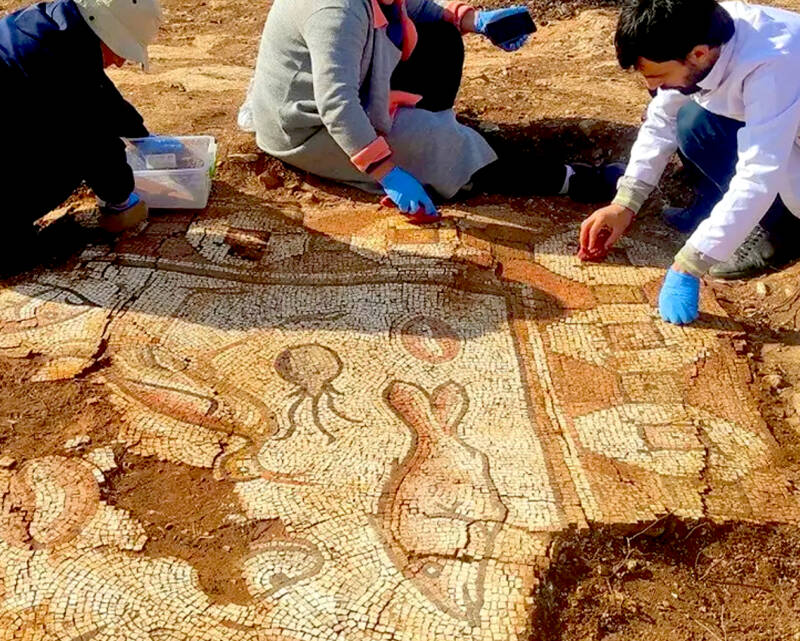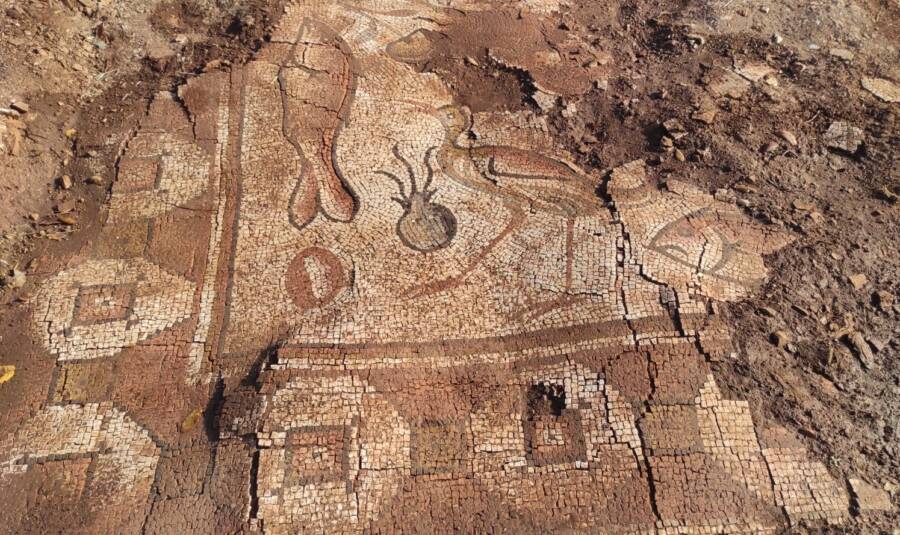Depictions of marine wildlife ranging from octopuses to eels make these mosaics unlike anything ever found in the region before.

Anadolu AgencyFound in remarkably good condition, the mosaics feature sea creatures like octopuses, mussels, and seals.
In October 2023, archaeologists were summoned to an area known as Kela Hanma (Lady’s Castle) in Turkey’s southeastern Mardin province on a rescue mission. They’d heard reports of illegal excavations in the area, so they set out to protect the artifacts that remained. Though they encountered significant damage at the site, they also made a stunning find: an intricate Roman mosaic.
This astonishing mosaic stretches across 1,000 square feet and features geometric patterns including triangles, hexagons, octagons and arches as well as marine wildlife like octopuses, fish, mussels, seals, and aquatic plants.
“These mosaics, adorned with animal figures and rare sea creatures like octopuses and various fish species, are distinctive in this region,” Abdulghani Tarkan, the director of the Mardin Museum, explained. “Our priority is to preserve these historical relics to prevent further deterioration.”

Anadolu AgencyDepictions of marine wildlife make these mosaics unlike anything ever found in the region before.
Kela Hanma, where the mosaics were discovered, is the site of a Roman settlement that dates back to the fifth to seventh centuries C.E. Tucked in the forest between the Kızıltepe and Artuklu districts, it’s home to a number of archaeological treasures.
The mosaics were part of a villa rustica, a settlement enclosed by walls that contained a number of buildings, including servants’ living quarters and a necropolis as well as a pars urbana (main house) and the pars rustica (farm area), according to Heritage Daily.
More than a millennium ago, such a place would have been inhabited by both the landowner and his family as well as the family’s servants. These luxurious Roman farmhouses were built more for leisure than agriculture and served as places where wealthy landowners could come to the countryside to relax, aided by a team of attendants.
But the site is also much more than just the villa rustica.
“The area is not just limited to the rural villa. There are different architectural remnants on the southern slope and a necropolis area,” Tarkan explained.

Anadolu AgencyThe mosaics, which featured motifs like this octopus, were discovered in the settlement’s villa rustica, where a landowner and his family once lived.
As such, it’s concerning that the area has been the target of illegal excavations in the past. When the archaeologists arrived at Kela Hanma in October, they found a number of unauthorized excavation pits, which caused considerable damage to the archaeological ruins.
Experts maintain that such a site should be protected, especially because it’s part of Mardin’s impressive history. The city of Mardin, just 20 miles away from Kela Hanma, has a history that stretches back thousands of years. As CNN reports, it was inhabited by Nabataean Arabs from 150 B.C.E. to 250 C.E. and was later occupied by Assyrians, Romans, and Byzantines.
Near Mardin, archaeologists have made stunning finds from the Roman era in recent years, like an elaborate olive workshop from the sixth century that hints at the region’s importance. And within the city itself, a ruined Roman citadel — which was rebuilt in the Middle Ages — remains a popular attraction.
As such, the mosaics found in Kela Hanma are part of the region’s larger historic tapestry and archaeologists are anxious to protect them from additional damage. Next, they will be carefully removed from the villa rustica where they’ve sat for some 1,500 years and transported to the Mardin Museum.
There, their stunning depictions of octopuses, mussels, and waterfowl can be enjoyed by the public — and protected from further harm.
After reading about the stunning Roman mosaics found in Turkey, see the 2,000-year-old Roman mosaic that was discovered right next to London’s iconic Shard building. Then, discover how archaeologists in Israel came across a 1,500-year-old mosaic that featured scenes from life on the Nile.





